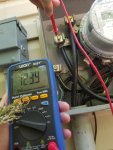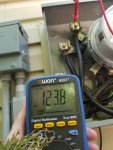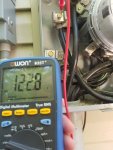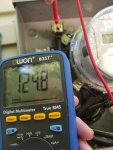Hi, I have run into a strange issue and can't seem to find any good information on this so I am hoping someone here can help me understand how this can happen. We have been having some mild electrical issues in our home ranging from flickering lights to computer hardware damage. We have had 2 electricians out to check the electrical wiring in our panel and everything seems to check out. We then had our electrical provider out to check the wiring in our meter base and the guy they sent said all the wiring looks good, but he also measured the current on both of our hot legs and on our neutral and discovered that our neutral current is not equal to the difference of the two hot legs. I spoke to our electrician again and he told us to get both hot legs to 20 amps and check the neutral current again. I got phase A to 20.1 amps and phase B to 20.3 amps and our neutral current was still showing 7 amps. Clearly something isn't how it should be. So my question is how is this possible?
You guys are way more educated than I am, so ... if I make you laugh, don't insult me too hard.
It seems to me that the OP has gotten way off track. While it's intriguing to see all the different wave forms, the original problem seems to have either disappeared or has been put on the back burner.
If the power company has a deteriorating neutral in their distribution system, there can be current flowing through their neutral to a very well grounded house panel because the earth is a parallel path for the distribution system neutral.
Jhardy13, did you ever check for a deteriorating neutral coming into your service by checking voltages between L1/N, L2/N, and L1/L2 while unloaded and then again loading just one L?
Let me share this story with you. The PoCo service man showed up at my neighbor's house one day. Being the inquisitive guy I am, I asked my neighbor what was going on. They said they were having some light dimming and flickering problems. The tech checked the voltages and said everything is fine. Well me being me, ... I asked if he could hold on for a minute (he was packing up to leave). I had my neighbor turn on a hair dryer while I was watching voltages and one L went up while the other went down when measured to N and L/L was stable. I told the tech that they had a neutral going bad and everything is not okay. He argued a little but went to his truck and called his supervisor.
He came back with what he called "the beast". Plugged it into the meter socket, did some testing, then told my neighbor they had a neutral problem and a digging crew would be out to find the problem. It turned out there was a splice (that was deteriorating) near the street and they were able to repair it that day.
I had a marina one time that had a voltage between the waterway and the ground of the electrical system. The only way to get rid of that voltage was to disconnect the PoCo neutral. This told me the PoCo neutral had enough VD that a couple of volts developed between the waterway and the PoCo neutral.
Electricity takes all paths.
So, being the dummy I am, I would check voltages while loading one L, and I would check for current on the PoCo neutral with all breakers off. If there is current on the PoCo neutral, then I would try to determine if it's going to ground through the GEC or if it's going to ground through the well connection.
Flickering lights and computer damage are typical signs of a deteriorating neutral. I think this has been covered already, but since this thread keeps going I thought I might repeat some of these things. Smart people sometimes overthink things. Sometimes.
















